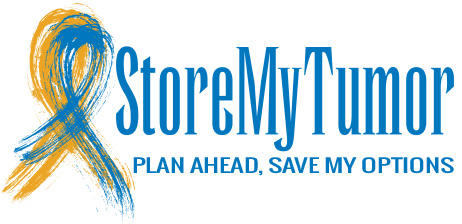FREQUENTLY ASKED QUESTIONS
COMMON MISCONCEPTIONS
1. Doesn't my hospital / pathology / doctor store my tumor?
Hospitals generally keep only a very small piece of the tumor for their own purposes, and usually it’s preserved in paraffin (dead). In contrast, StoreMyTumor preserves as much tumor as possible in various formats, frozen viable, frozen fixed, and/ or in paraffin. This is because different application require different formats. StoreMyTumor maximizes the opportunities patients have to use their tissue for their own benefit.
Many patients ask the surgeon/oncologist/hospital if the hospital will store their tumor, and the answer is typically a misleadingly yes. This is because hospitals preserve a small part in paraffin (dead), but not in multiple formats. Only some large cancer centers preserve tumors frozen fixed (not alive), but this is not for patient use, it is rather for internal research projects that help advance science.
StoreMyTumor preserves tumor is multiple formats, and for the patient to use and benefit from.
3. My doctor thinks that my tumor is too small, and won't be sufficient for any later use, is he/she right?
Absolutely not. There is no way for anyone to tell how many cancer cells are in a certain volume of tissue. If you have a small tumor, it does not necessarily mean you have a small number of cancer cells. Many factors play a role, including previous treatments you have had that affected the viability of the cancer cells, the stage and type of your cancer, and the desired final use. Call us so we will guide you through the decisions and help you prioritize based on the amount of tissue available.
4. My doctor is confident in chemo and radiation. Why do I need to think about advanced diagnostics or experimental trials now?
Although “standard of care” treatments (chemo and radiation) can be effective in the short termposteriorany people will not respond as anticipated, or respond but later develop resistance, or find the side effects over time too much to bear. Each person and cancer is unique, and trying to predict who might respond best is tricky. Keeping all of the options open, through viable tumor preservation, is like an insurance policy for the future.
TECHNICAL QUESTIONS
1. Why does the tumor need to be stored alive (“viable”)?
Certain treatments (like cancer vaccines and TILs) and diagnostics (like chemo sensitivity) require live cancer cells. Cancer vaccines and TILs are manufactured from live cancer cells, and chemo sensitivity studies the response of of the live cancer cells to certain chemo and drugs. These cells must be collected during surgery and preserved sterilely and alive.
2. What types of tumors do you preserve?
All diseases. All sizes (including biopsies). Solid and fluid (ascites). Ascites is every bit as powerful as a solid tumor for most applications. In fact, it is sometimes more dense with cancer cells.
3. Will my surgeon know how to collect the tissue?
Here at StoreMyTumor, we appreciate that you’ll have a lot on your mind on your day of surgery. We have worked with many hospitals and cancer centers and our tumor collection and storage process has been designed to ensure simplicity for you and your surgical team.
A collections kit with detailed instructions for your surgeon will be sent to you (or a family member) prior to your surgery. You simply hand it off to the surgical team on the day of surgery. We coordinate shipping details and streamline the logistics. We are available to answer any questions and to work with your medical team so you can concentrate on what’s most important – YOU!
4. I’ve had chemo. Can I still store my tumor viably?
Yes. If you’re having surgery, it means tumor remains, even after chemo. Tissue that has been killed by the chemo will be trimmed away so we preserve only the cancerous tissue.
5. Can stored tissue be re-formatted?
Options to re-format stored tissue are limited. Dead cells (flash frozen or in paraffin) cannot be brought back to life (viable). Similarly, once the tissue is digested into cells, it cannot be rebuilt back into tissue. For this reason, the more you tell us about the final purpose the more we can help you store it in the right format form the beginning.
6. How long can the tumor stay preserved?
It can be stored for very long periods of time (tens of years or more) without significant loss in cell viability.
7. Do you accept ascites (fluid tumors)?
Yes absolutely. Contrary to the general perception, Ascites are quite potent in cancer cells and good to preserve.
8. How much tumor is required? My tumor is very small, so does it make sense to store it?
The simple answer is: store as much as possible. More tissue typically means more options, and cost is the same for any volume you send us. All tissue is valuable; even a biopsy is useful. We recommend storing as much tumor tissue and fluid as possible (fluid is just as good as solid). Also, if you have a small tumor, it does not necessarily mean you have a small number of cancer cells. Many factors play a role, including previous treatments you have had that affected the viability of the cancer cells. The question of “enough” also depends on the desired application. Call us so we will guide you through the decisions and help you prioritize based on the amount of tissue available.
LOGISTICAL QUESTIONS
1. I need a kit right away. Can you help?
Call us immediately please. While we typically ship each kit via overnight delivery, we understand that emergency (same-day) situations sometimes arise. Some of the large cancer centers in the US have our kits on stand-by in their pathology departments. We can also send instructions for collection and shipment without a kit. It is a good option when all else fails, and we will work closely with your surgical team to ensure success.
2. I live or am having surgery outside of the US. Can you still store my tumor?
Yes, we service almost all countries. call us of more
3. How quickly does the tumor need to be sent to your facility?
We ask that the tissue be handed to the courier on the same day it is removed from the body, and without delays. We will track the shipment closely so our lab can prepared to process it upon receipt. Our transport media is optimized to handle shipping delays.
4. Where will my tumor be stored and how do I access it when needed?
StoreMyTumor works for you, and you will maintain access to your tissue at all times. All tumors are processed on arrival and stored in our specialized lab. When you and your doctor decide to use it for testing or treatment, we take instructions from you. Simply make a request for us to prepare and transfer some or all of the tissue, and we’ll take care of the rest!
5. What is "digestion," and should I request it?
If you do not know what digestion means, then you probably do not need it. Generally, solid tumors can be preserved viably as tissue or digested into single cells. We routinely preserve solid tumors as tissue but can digest (an additional fee applies) at the time of initial preservation or later. If you are interested in a specific application/clinical trial and were told that that application requires single cells, we would recommend upfront digestion (to maximize the cell yield). Additionally, if the specimen is very small (smaller than a sugar cube) and you are interested in whole tumor vaccines, we may recommend upfront digestion.
Digestion can also be performed anytime after the initial cry-preservation, as needed. Generally, we can digest tissue into cells anytime, but not the other way around. While upfront digestion maximizes the live-cell yield, some applications/clinical trials require live tissue, so it is safer (keeps more options open) not to digest if not required. Call us and we will help you with this decision, based on your specific situation.
6. What if the storage facility loses power?
Our storage facilities are state-of-the-art, with back-up systems in place for power outages. They can be fully operational for weeks without electricity.
FINANCIAL QUESTIONS
1. Are there other organizations that offer this type of service?
Currently, Store My Tumor is the only organization that offers viable tumor storage and logistics services privately. We are a trusted partner for cutting-edge cancer centers worldwide. Live tumor storage requires top-quality facilities, highly-skilled technicians, and precise timing and logistics (in other words, zero mistakes). We take this responsibility very seriously
2. What is the cost to collect, process and store my tumor?
Costs associated with tissue cryopreservation depend on the formats required. Our services include a specially-prepared collection kit, shipping, custom processing and a research consultation. Please contact us to discuss details. Once we understand your needs and priorities, we’ll send a registration packet which outlines the recommended storage options and costs of our services.
3. Is this expense covered by insurance?
While we have had a couple of patients successfully receive reimbursement from their insurance companies, we generally set the expectation that this is an out-of-pocket expense. We will provide an itemized invoice that you can use to submit a claim.
4. I can’t afford the service. Can StoreMyTumor help?
Depending on your situation, financial assistance may be available. We understand that a cancer diagnosis comes with numerous unplanned financial demands. Please ask for a Financial Assistance application to submit with your registration. We will try hard to not let cost stand in the way of your commitment to your future.
POLICY QUESTIONS
1. Who owns my tumor?
Generally, tumor samples stored by a hospital belong to the hospital, not the patient. The hospital uses your tumor sample for its own research, and you will likely not have access to it or the right to use it for your own purposes outside of that hospital. With StoreMyTumor, you have control over your tissue. We take direction from you or your authorized clinician in terms of where and when to transfer specimens to. We can transfer within the USA or internationally.
2. Do you have a refund policy?
Store My Tumor processes all specimens on arrival, and cannot refund fees once processed. This is because SMT incurs the cost of processing specimens regardless of the quality or volume of the specimen received, or whether the specimen proves cancerous or not, or whether the specimen yield a large number of cells or not, or whether the specimen is accepted and/or used by the desired final application.
3. What happens to the stored specimen after death?
After death, clients are given a 90 day period before they automatically relinquish all rights in and to the specimen and waiving all claims to the specimen. In this 90 days period, some family members decide to continue to pay the storage fees and keep it indefinitely. Some choose to have the tissue donated to specific institutions for immediate research purposes, in which case StoreMyTumor can coordinate the transfer within the first 90 days with the cost of release and transport billed to the family. Some families decide to actively terminate their storage responsibility (which they are allowed to do anytime) and relinquish all rights in and to the specimen and waive all claims to the specimen.

